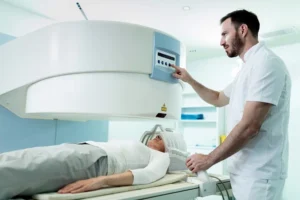Dysmenorrhea (Menstrual Cramps): Causes, Symptoms, Diagnosis, Treatment
- Updated on: Jun 29, 2024
- 6 min Read
- Published on Apr 22, 2019

Dysmenorrhoea Definition: What is Dysmenorrhoea (Menstrual Cramps)?
Dysmenorrhoea is the medical term for pain associated with menstruation (periods). It is also known as menstrual cramps and is the most commonly reported menstrual disorder. More than one half of women who menstruate have some pain for 1-2 days each month.
What do period cramps feel like?
Menstrual cramps (period cramps) are usually sharp but may be throbbing or cramping pains or a dull and constant ache in the lower abdomen which may radiate to the legs. Many women experience menstrual cramps just before and during their menstrual periods. Pain tends to peak 24 hours after onset of menses and subside after 2 to 3 days.
For many women, the painful experience is merely annoying. For most of them, menstrual cramps can be severe enough to interfere with everyday activities for a few days every month.
Dysmenorrhoea is generally accompanied by headache, nausea, constipation, diarrhoea, lower back pain and frequent urination. Vomiting is also experienced by some.
Dysmenorrhoea usually happens for the first time a year or two after a girl first gets her period, and become less painful with age and may stop entirely after you have your first baby.
What are the types of dysmenorrhoea?
There are two types of dysmenorrhoea:
- Primary dysmenorrhoea
- Secondary dysmenorrhoea
What is primary dysmenorrhoea?
It is common menstrual cramps that are not due to other diseases and are recurrent in nature. Pain usually starts 1 or 2 days before, or when menstruation starts, and is felt in lower abdomen, back, or thighs.
It typically last for 12 to 72 hours and pain can range from mild to severe.
This kind of menstrual cramps becomes less painful with age and may disappear entirely after a woman has a baby.
What is secondary dysmenorrhoea?
This type is due to some physical cause or a disorder in a woman’s reproductive organs, such as:
- Endometriosis – In this condition, tissues from the lining of the uterus is found outside the uterus, such as in the ovaries and fallopian tubes, behind the uterus, and on the bladder.
- Adenomyosis – Tissue that normally lines the uterus begins to grow in the muscle wall of the uterus.
- Uterine fibroids – These are the growths that form on the outside, on the inside, or in the walls of the uterus. Fibroids located in the uterus can cause pain.
- Infection
- Congenital malformations such as transverse vaginal septum
- Ovarian cysts and tumours
- Pelvic inflammatory disease
It is most often observed in women aged 30-45 years. Pain from secondary dysmenorrhoea usually begins earlier in the menstrual cycle and lasts longer than common menstrual cramps. This pain is not typically accompanied by nausea, vomiting, fatigue or diarrhoea.
What causes dysmenorrhoea? What are the main causes of secondary dysmenorrhoea?
Primary dysmenorrhoea is caused by abnormal contraction (tightening) of the uterus (where a baby grows) by a chemical called prostaglandin.
The uterus contracts throughout a woman’s menstrual cycle and during menstruation it contracts more strongly, pressing against the nearby blood vessels which cuts off the oxygen supply to the muscle of the uterus resulting in pain or menstrual cramps.
Some other factors contributing to primary dysmenorrhoea may include:
- A narrow cervical opening
- Passage of menstrual tissue through the cervix
- A mal-positioned uterus
- Anxiety about menses
- Lack of exercise
Secondary dysmenorrhoea is caused by other medical complications of woman’s reproductive organ, most often endometriosis. Endometriosis generally causes internal bleeding, infection and pelvic pain.
Other causes of secondary dysmenorrhoea may include:
- Pelvic inflammatory disease
- Uterine fibroids
- Cervical stenosis
- Infection, tumours, or polyps in the pelvic cavity
- Abnormal pregnancy
- Intrauterine contraceptive devices (IUCDs)
What are the signs and symptoms of dysmenorrhoea?
Symptoms of dysmenorrhoea may include:
- Throbbing or cramping pain in your lower abdomen that may be intense
- Dull, constant ache
- Pain that may radiate to your lower back, thighs and hips
- Nausea
- Vomiting
- Diarrhoea
- Fatigue
- Weakness
- Fainting
- Headaches
These symptoms may overlap with symptoms of other medical conditions. It is always advised to consult your doctor for proper diagnosis of dysmenorrhoea.
Lower back pain feels like I have to poop – Do menstrual cramps feel like you have to poop?
This is because of prostaglandins. These are the chemical signals that bodies produce in women. These are sent to the uterus to tell it to contract. This causes expelling of the uterine lining toward the end of your menstrual cycle.
But not all women feel the same. If your body sends enough of prostaglandins to the uterus, some of them may move to the bowel, which is close to the uterus. They may then ask the bowel also to contract, causing them to expel whatever is contained there.
Therefore, not all women experience frequent bowel movements in their periods. Some girls feel the effects of prostaglandin on their bowels as nausea. Some may get diarrhea. And others are not affected by it at all.
What are the risk factors for dysmenorrhoea?
The population which is at greater risk of dysmenorrhoea include:
- Women younger than age 30
- Women who hits puberty at early age ( 11 or younger- early menarche)
- Women having heavy bleeding during periods (menorrhagia)
- Women having irregular menstrual bleeding (metorrhagia)
- Women who never gave birth (nulliparity)
- Women having family history of dysmenorrhoea
- Women who are frequent smoker
- Obese women
Various pathological conditions such as endometriosis and pelvic inflammatory disease serve as risk factors for secondary dysmenorrhoea.
How is dysmenorrhoea diagnosed?
If you are experiencing severe or unusual menstrual cramps or cramps that last more than 2 or 3 days, contact your doctor. Both primary and secondary menstrual cramps can be treated, so it’s important to get diagnosed.
Your doctor will review your medical history and perform a physical exam such as a pelvic exam.
During the pelvic exam, your doctor will check for any abnormalities or defect in reproductive organs – vagina, cervix, and uterus and look for any signs of infection. A small sample of vaginal fluid may be taken out for testing.
If your doctor suspects an underlying disorder for your secondary dysmenorrhoea, he/she may recommend for further testing. If a medical problem is found, your doctor will discuss treatments.
Tests and methods for diagnosing cause of dysmenorrhoea
Various diagnostic tests may include:
- Ultrasound: This test creates an image of your uterus, cervix, fallopian tubes and ovaries by using sound waves.
- Computed tomography (CT) scan: It provides more details than an ultrasound and can help your doctor in diagnosing the underlying cause more precisely.
- Magnetic resonance imaging (MRI): It uses radio waves and magnetic fields to produce detailed images of your internal structures. It is non-invasive and painless.
- Laparoscopy: This procedure is not necessary for the diagnosis of menstrual cramps, but it can help in detecting any underlying condition, such as endometriosis, adhesions, fibroids, ovarian cysts and ectopic pregnancy.
- Hysteroscopy: This is a visual exam of the canal of the cervix and inside of the uterus using a hysteroscope (a viewing instrument) inserted through vagina.
What are the treatment options for dysmenorrhoea?
Dysmenorrhoea can be treated. Your doctor will determine specific treatment for your menstrual cramps based on:
- Your age, medical history and overall health
- Extent of the condition
- Cause of the condition (primary or secondary)
- Your tolerance for specific medications, procedures or therapies
Your doctor may recommend one of the following:
Pain relievers
Your doctor may recommend over-the-counter pain relievers such as aspirin and ibuprofen or prescription non-steroidal anti-inflammatory drugs (NSAIDs) such as acetaminophen and mefnamic acid to treat symptoms of pain in dysmenorrhoea.
Hormonal birth control
Birth control pills contain hormones that prevent ovulation and reduce the severity of menstrual cramps.
Surgery
If menstrual cramps are of secondary kind, which are caused by an underlying disorder such as endometriosis or fibroids, surgery is employed to correct the problem that may help in reducing your symptoms.
Surgical removal of uterus (hysterectomy) is also an option if you are not planning to have baby in future.
Endometrial ablation (procedure to destroy the lining of the uterus) and endometrial resection (procedure to remove the lining of the uterus) are also helpful in relieving in severe symptoms of menstrual cramps.
What are the alternate therapy options for dysmenorrhoea?
Some alternative therapies have been proved to be beneficial for many women who do not respond to NSAIDs and oral contraceptives or if these agents are contraindicated in them.
Some of such therapies are:
- Acupuncture
- Transcutaneous electrical nerve stimulation (TENS)
- Herbal medicines such as pycnogenol and funnel and their combination products
- Acupressure
How can dysmenorrhoea be prevented? How dysmenorrhoea can be relieved?
Adapting to a healthy lifestyle is important for the prevention of dysmenorrhoea. Following strategies can be followed to prevent or relieve it at home.
- Diet changes (decrease sugar and caffeine intake with increase in protein intake)
- Regular exercise
- Vitamin supplements
- Use heating pad across abdomen
- Take hot bath or shower
- Abdominal massage
- By reducing stress
- Avoid smoking and drinking
What are the complications of dysmenorrhoea?
Dysmenorrhoea doesn’t cause any other medical complications, but it can interfere with daily life, work, and social activities.
Certain conditions associated with dysmenorrhoea may have their own complications. For example, endometriosis can cause fertility problems. Pelvic inflammatory disease can scar your fallopian tube and increase the risk of ectopic pregnancy (implantation of fertilized egg outside of your uterus).












1 Comment
I have been exploring for a bit for any high quality articles or blog posts on this sort of area . Exploring in Yahoo I at last stumbled upon this website. Reading this info So i am happy to convey that I have a very good uncanny feeling I discovered exactly what I needed. I most certainly will make sure to don’t forget this web site and give it a glance regularly.